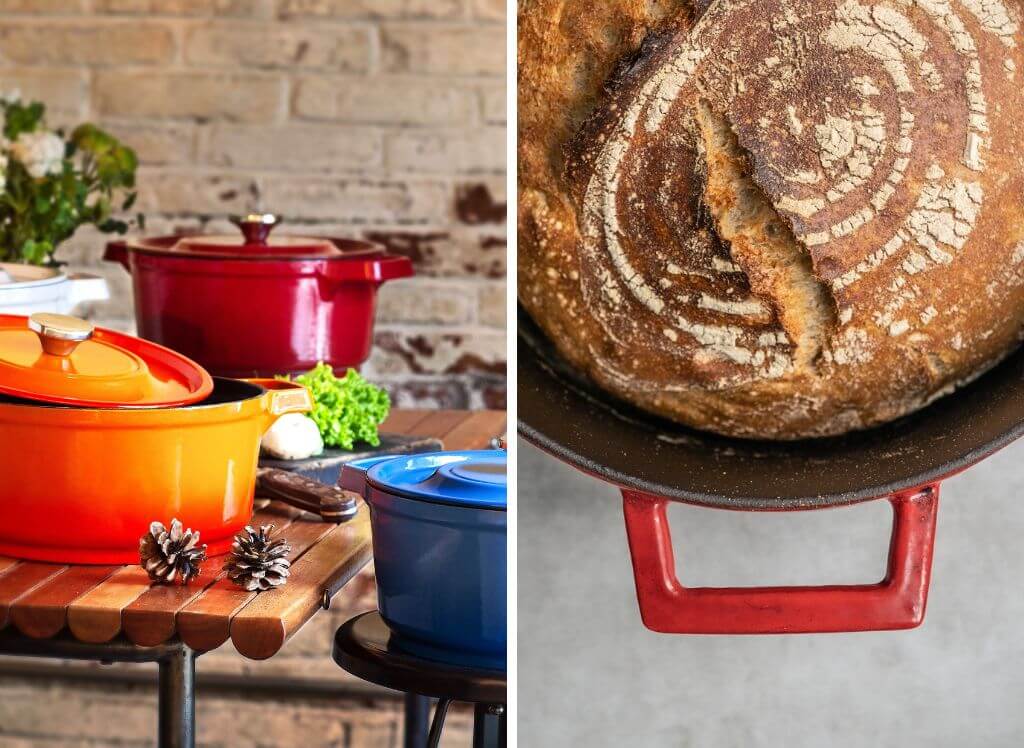If you're looking to take your cooking to the next level, investing in a Dutch oven is a great way to do it.
A Dutch oven is a versatile piece of cookware that can be used for a variety of dishes, from stews and soups to roasts and bread.
However, before you start cooking with your Dutch oven, it's important to season it properly.
In this article, we'll guide you through the process of seasoning a Dutch oven, step by step.
A Dutch oven is a heavy, thick-walled pot made of cast iron or ceramic.
It has a tight-fitting lid that traps in heat and moisture, making it ideal for slow-cooking dishes.
Seasoning a Dutch oven is the process of coating it with oil and baking it in the oven to create a non-stick surface.
This is important because it prevents food from sticking to the pot and makes it easier to clean.

Guide to Seasoning Dutch Ovens
- A Dutch oven is a versatile cooking tool that needs to be seasoned before use.
- The process involves cleaning, choosing the right oil, preheating the oven, applying oil, and baking the oven.
- Alternative methods and troubleshooting tips are also provided.

Clean the Dutch Oven
Before you can season your Dutch oven, you need to make sure it's clean. Follow these steps to clean your Dutch oven:
- Fill the Dutch oven with hot water and a small amount of dish soap.
- Use a soft-bristled brush or sponge to scrub the inside of the pot.
- Rinse the pot thoroughly with hot water.
- Dry the pot with a clean towel.
Choose Your Oil
The type of oil you use to season your Dutch oven is important.
You want to choose an oil that has a high smoke point, which means it can withstand high temperatures without burning or smoking.
Some good options include vegetable oil, canola oil, and grapeseed oil. Avoid using oils with a low smoke point, such as butter or olive oil, as they can burn and leave a sticky residue on the pot.

Preheat the Oven
Before you apply the oil to your Dutch oven, you need to preheat your oven. Preheat your oven to 375°F.
Apply Oil
Once your oven is preheated, it's time to apply the oil to your Dutch oven. Follow these steps:
- Pour a small amount of oil into the Dutch oven.
- Use a paper towel or a clean cloth to spread the oil evenly over the inside of the pot.
- Cover all areas, including the sides and the lid.
- Use a clean paper towel to wipe off any excess oil.
You don't want to use too much oil, as this can cause the pot to become sticky. A thin layer of oil is all you need to create a non-stick surface.
Personal Experience: Choosing the Right Oil
When I first started seasoning my Dutch oven, I thought any oil would work.
I used olive oil, which has a low smoke point, and ended up with a sticky mess. After doing some research, I learned that the type of oil you use is crucial to the seasoning process.
I switched to flaxseed oil, which has a high smoke point and creates a hard, non-stick surface on the Dutch oven.
The difference was incredible. My Dutch oven now heats evenly and nothing sticks to it.
If you're unsure which oil to use, do some research and choose an oil with a high smoke point. It's worth the investment for a perfectly seasoned Dutch oven.

Bake in the Oven
Now that you've applied the oil to your Dutch oven, it's time to bake it in the oven. Follow these steps:
- Place the Dutch oven upside down on the middle rack of your oven.
- Bake for 1 hour.
- Turn off the oven and let the Dutch oven cool down inside the oven.
- Repeat the seasoning process 2-3 more times.
The more you season your Dutch oven, the better the non-stick surface will become. After each seasoning, you'll notice that the pot becomes darker and shinier.
Alternative Dutch Oven Seasoning Methods
While the oven method is the most common way to season a Dutch oven, there are other methods you can use.
One popular method is to season the pot on the stovetop.
To do this, heat a small amount of oil in the Dutch oven over medium heat for 15-20 minutes, then let it cool down. You can repeat this process 2-3 more times.
Storing a Cast Iron Dutch Oven
Now that you've seasoned your Dutch oven, it's important to store it properly. Follow these tips:
- Make sure the Dutch oven is completely dry before storing it.
- Store the Dutch oven with the lid off to prevent moisture from building up inside.
- Place a paper towel or cloth inside the Dutch oven to absorb any moisture.
- Store the Dutch oven in a dry, cool place.

Troubleshooting
If your Dutch oven becomes sticky, try washing the pot with hot water and a small amount of dish soap.
If that doesn't work, you can try scrubbing the pot with a mixture of coarse salt and oil.
If your Dutch oven develops rust, you can remove it by scrubbing it with steel wool and then re-seasoning it.
Conclusion
Seasoning your Dutch oven is an important step in ensuring that your meals come out perfectly.
Remember to choose the right oil, preheat your oven, and repeat the seasoning process 2-3 times for the best results.
With a properly seasoned Dutch oven, you'll be able to create delicious meals for years to come.
FAQs
Who should season their Dutch oven?
Anyone with a cast iron Dutch oven, whether new or old, should season it to ensure its longevity and optimal cooking performance. Regular seasoning prevents rust, creates a non-stick surface, and enhances the flavor of food.
What is the purpose of seasoning a Dutch oven?
The purpose of seasoning a Dutch oven is to create a protective, non-stick layer that prevents rust and enhances the flavor of food cooked in it. Regular seasoning ensures the longevity and optimal performance of the cast iron vessel.
How do you season a Dutch oven?
To season a Dutch oven, first clean it and coat its entire surface with a thin layer of cooking oil or a vegetable oil or shortening. Then, bake it upside down at 375°F for an hour, allowing it to cool in the oven afterwards to achieve a shiny, non-stick surface.
What oil should I use to season my Dutch oven?
For seasoning a Dutch oven, it's best to use vegetable shortening or oil due to their high smoke points and effectiveness in creating a protective layer. Flaxseed oil is also a popular choice for its durable seasoning finish.
How often do I need to season my Dutch oven?
You should season your new Dutch oven initially and then re-season it whenever food starts sticking or if it appears dull or rusty. Regular use and proper care can reduce the need for frequent seasoning.
What if my Dutch oven still has rust after seasoning?
If your Dutch oven still has rust after seasoning, you should scrub the rusted areas with a mixture of coarse salt and water using a stiff brush or steel wool until the rust is removed. After cleaning, rinse thoroughly, dry completely, and then re-season the oven to protect it from future rusting.











